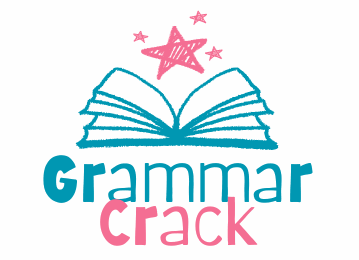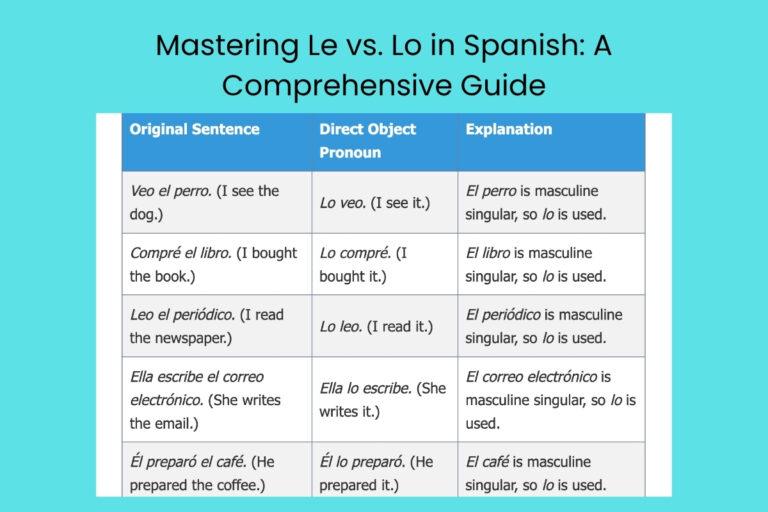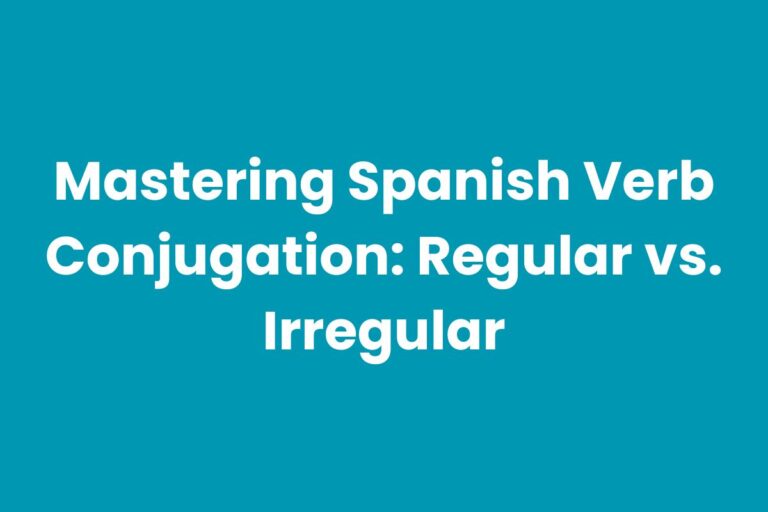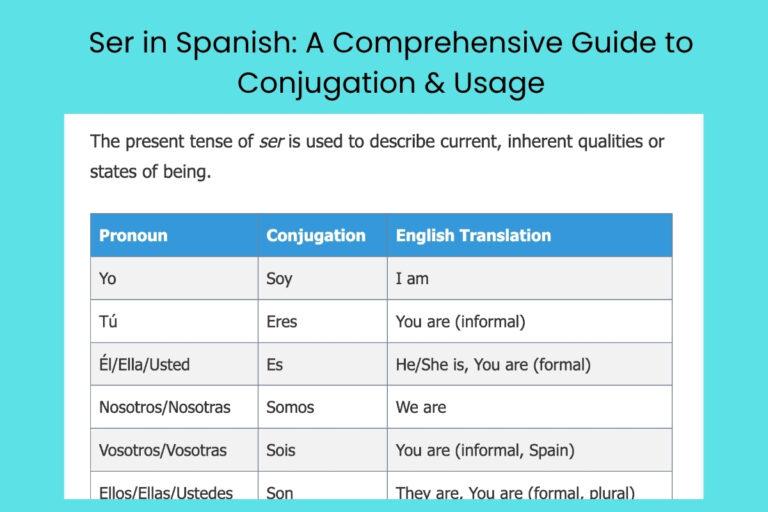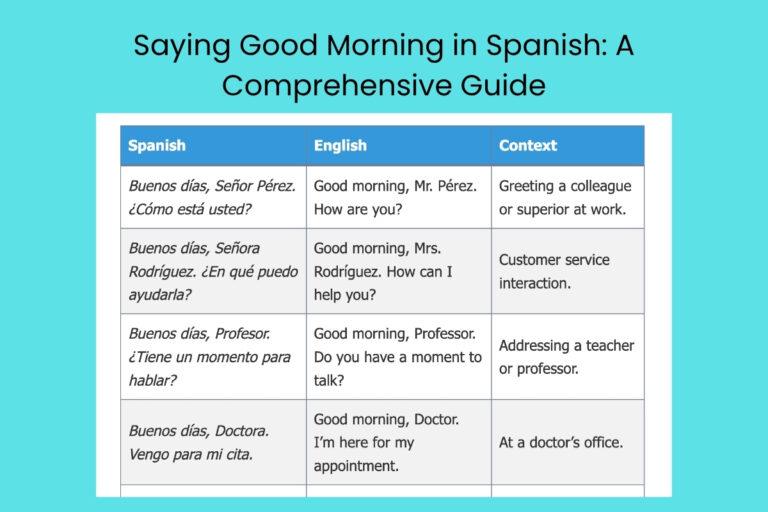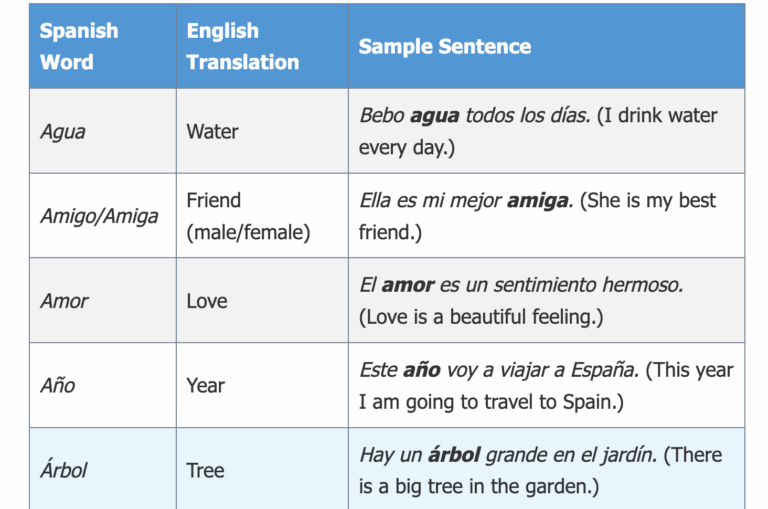Mastering Spanish Reported Speech: A Comprehensive Guide
Reported speech, also known as indirect speech, is a fundamental aspect of Spanish grammar. It allows us to convey what someone else has said without directly quoting them.
Understanding how to correctly transform direct speech into reported speech is crucial for effective communication, both in spoken and written Spanish. This guide will provide a detailed exploration of the rules, changes, and nuances involved, making it accessible to learners of all levels.
Whether you’re a beginner or an advanced student, this comprehensive resource will equip you with the knowledge and practice needed to confidently use reported speech in Spanish.
Table of Contents
- Definition of Reported Speech in Spanish
- Structural Breakdown of Reported Speech
- Types and Categories of Reported Speech
- Examples of Reported Speech
- Usage Rules for Reported Speech
- Common Mistakes in Reported Speech
- Practice Exercises
- Advanced Topics in Reported Speech
- Frequently Asked Questions
- Conclusion
Definition of Reported Speech in Spanish
Reported speech, also known as indirect speech (estilo indirecto), is a grammatical structure used to report what someone else has said, thought, or asked without quoting their exact words. Instead of presenting the original speaker’s words verbatim, we paraphrase their message while making necessary grammatical adjustments to fit the new context. This often involves changes in verb tenses, pronouns, and adverbs to maintain grammatical consistency and accuracy.
The primary function of reported speech is to convey information about a previous utterance. It allows us to summarize or rephrase what someone else said, making it an essential tool for communication in various contexts, including conversations, news reports, and formal writing.
In Spanish, mastering reported speech is crucial for understanding and producing complex sentences and accurately conveying information from different sources.
Reported speech can be classified based on the type of original utterance being reported: statements, questions, and commands. Each type requires specific grammatical transformations to ensure the reported version accurately reflects the original meaning.
Understanding these different types and their corresponding changes is key to mastering reported speech in Spanish.
Structural Breakdown of Reported Speech
The basic structure of reported speech in Spanish typically involves a reporting verb followed by a conjunction (usually que) and then the reported clause. The reporting verb introduces the act of reporting, such as decir (to say), preguntar (to ask), responder (to answer), afirmar (to affirm), or negar (to deny). The choice of reporting verb can influence the nuance and emphasis of the reported message.
The conjunction que acts as a bridge between the reporting clause and the reported clause. It signals that what follows is a paraphrase of someone else’s words. In the case of reported questions, the conjunction si (if/whether) is used for yes/no questions, while interrogative words (qué, quién, dónde, cuándo, cómo, cuál) are used for wh-questions.
The reported clause itself undergoes several transformations, including changes in verb tenses, pronouns, and adverbs. These changes are necessary to maintain grammatical consistency and ensure that the reported message is accurate in its new context.
The specific changes required depend on the original tense of the verb, the relationship between the speaker and the reporter, and the time and place of the original utterance.
For example, consider the following sentence in direct speech: “Voy al cine mañana,” said Maria. In reported speech, this might become: Maria dijo que iba al cine al día siguiente. Notice how the verb tense changes from present to imperfect, and the adverb mañana changes to al día siguiente. These changes are crucial for accurately reflecting the original message in its new context.
Types and Categories of Reported Speech
Reported speech in Spanish can be categorized into three main types, each requiring specific grammatical adjustments:
Statements
Reporting statements involves conveying information that someone has declared or asserted. The reporting verb is typically a verb of saying, such as decir, afirmar, explicar, or comentar. The conjunction que is used to introduce the reported clause. Tense changes, pronoun changes, and adverb changes are often necessary to maintain grammatical consistency.
Questions
Reporting questions involves conveying a question that someone has asked. The reporting verb is typically a verb of asking, such as preguntar, inquirir, or querer saber. For yes/no questions, the conjunction si is used. For wh-questions, the original interrogative word is retained. Tense changes and pronoun changes are also necessary, but the word order remains the same as in direct questions (subject-verb inversion is not used).
Commands
Reporting commands involves conveying an order or request that someone has given. The reporting verb is typically a verb of ordering or requesting, such as decir, mandar, pedir, or rogar. The reported clause is usually introduced by que and uses the subjunctive mood. Pronoun changes are also necessary to reflect the change in perspective.
Examples of Reported Speech
The following examples illustrate the different types of reported speech in Spanish, along with the necessary grammatical adjustments.
Statements
Reporting statements requires careful attention to tense changes, pronoun adjustments, and adverb modifications to accurately convey the original message in a new context. The reporting verb, typically a verb of saying, sets the stage for the reported statement, while the conjunction que introduces the paraphrased content. The following table provides multiple examples, showcasing the transformation from direct to reported speech.
| Direct Speech | Reported Speech |
|---|---|
| Yo estudio español. | Él dijo que estudiaba español. |
| Tenemos un coche nuevo. | Ellos dijeron que tenían un coche nuevo. |
| Estoy cansado hoy. | Ella dijo que estaba cansada ese día. |
| Voy a viajar a España el próximo año. | Él comentó que iba a viajar a España el año siguiente. |
| He terminado mi trabajo. | Ella afirmó que había terminado su trabajo. |
| Compraré una casa. | Dijo que compraría una casa. |
| Salgo con mis amigos esta noche. | Él dijo que salía con sus amigos esa noche. |
| Visitaré a mi abuela mañana. | Ella dijo que visitaría a su abuela al día siguiente. |
| No quiero ir a la fiesta. | Él dijo que no quería ir a la fiesta. |
| Me gusta mucho el chocolate. | Ella dijo que le gustaba mucho el chocolate. |
| Estoy leyendo un libro interesante. | Él dijo que estaba leyendo un libro interesante. |
| Necesito tu ayuda. | Ella dijo que necesitaba mi ayuda. |
| Ella es mi mejor amiga. | Él dijo que ella era su mejor amiga. |
| Amo a mi perro. | Ella dijo que amaba a su perro. |
| Trabajo en una oficina. | Él dijo que trabajaba en una oficina. |
| Tengo dos hermanos. | Ella dijo que tenía dos hermanos. |
| Vivo en Madrid. | Él dijo que vivía en Madrid. |
| Estudio medicina. | Ella dijo que estudiaba medicina. |
| Me gusta cantar. | Él dijo que le gustaba cantar. |
| Quiero aprender a bailar. | Ella dijo que quería aprender a bailar. |
| Viajo mucho por trabajo. | Él dijo que viajaba mucho por trabajo. |
| Tengo mucho sueño. | Ella dijo que tenía mucho sueño. |
| Estoy muy feliz. | Él dijo que estaba muy feliz. |
| Entiendo español. | Ella dijo que entendía español. |
| Hablo ingles y frances. | Él dijo que hablaba ingles y frances. |
Questions
Reporting questions in Spanish requires careful attention to the type of question being reported. For yes/no questions, the conjunction si (if/whether) is used, while for wh-questions, the original interrogative word (qué, quién, dónde, cuándo, cómo, cuál) is retained. Unlike direct questions, reported questions do not use subject-verb inversion. Here are several examples that illustrate the changes necessary when converting direct questions into reported questions.
| Direct Speech | Reported Speech |
|---|---|
| ¿Estudias español? | Me preguntó si estudiaba español. |
| ¿Tienes un coche nuevo? | Me preguntaron si tenía un coche nuevo. |
| ¿Estás cansado hoy? | Me preguntó si estaba cansado ese día. |
| ¿Vas a viajar a España el próximo año? | Me preguntó si iba a viajar a España el año siguiente. |
| ¿Has terminado tu trabajo? | Me preguntó si había terminado mi trabajo. |
| ¿Comprarás una casa? | Me preguntó si compraría una casa. |
| ¿Sales con tus amigos esta noche? | Me preguntó si salía con sus amigos esa noche. |
| ¿Visitarás a tu abuela mañana? | Me preguntó si visitaría a su abuela al día siguiente. |
| ¿No quieres ir a la fiesta? | Me preguntó si no quería ir a la fiesta. |
| ¿Te gusta el chocolate? | Me preguntó si me gustaba el chocolate. |
| ¿Qué estás leyendo? | Me preguntó qué estaba leyendo. |
| ¿Quién es tu mejor amigo? | Me preguntó quién era mi mejor amigo. |
| ¿Dónde vives? | Me preguntó dónde vivía. |
| ¿Cuándo llegaste? | Me preguntó cuándo había llegado. |
| ¿Cómo te llamas? | Me preguntó cómo me llamaba. |
| ¿Cuál es tu color favorito? | Me preguntó cuál era mi color favorito. |
| ¿Por qué estudias español? | Me preguntó por qué estudiaba español. |
| ¿Cuánto cuesta este libro? | Me preguntó cuánto costaba ese libro. |
| ¿Cuántos años tienes? | Me preguntó cuántos años tenía. |
| ¿Trabajas aquí? | Me preguntó si trabajaba aquí. |
| ¿Me amas? | Me preguntó si la amaba. |
| ¿Te gusta bailar? | Me preguntó si le gustaba bailar. |
| ¿Puedes ayudarme? | Me preguntó si podía ayudarla. |
| ¿Sabes la respuesta? | Me preguntó si sabía la respuesta. |
| ¿Entiendes la pregunta? | Me preguntó si entendía la pregunta. |
Commands
Reporting commands involves conveying an order or request that someone has given. The reporting verb is typically a verb of ordering or requesting, such as decir, mandar, pedir, or rogar. The reported clause is usually introduced by que and uses the subjunctive mood. Pronoun changes are also necessary to reflect the change in perspective. The following table illustrates the changes involved in converting direct commands into reported commands.
| Direct Speech | Reported Speech |
|---|---|
| Estudia español. | Me dijo que estudiara español. |
| Ten cuidado. | Me dijeron que tuviera cuidado. |
| No llegues tarde. | Me dijo que no llegara tarde. |
| Viaja a España. | Me pidió que viajara a España. |
| Termina tu trabajo. | Me mandó que terminara mi trabajo. |
| Compra una casa. | Me sugirió que comprara una casa. |
| Sal con tus amigos. | Me aconsejó que saliera con mis amigos. |
| Visita a tu abuela. | Me rogó que visitara a mi abuela. |
| No vayas a la fiesta. | Me recomendó que no fuera a la fiesta. |
| Come chocolate. | Me insistió en que comiera chocolate. |
| Lee este libro. | Me pidió que leyera ese libro. |
| Sé amable. | Me dijo que fuera amable. |
| Haz tu tarea. | Me mandó que hiciera mi tarea. |
| Escribe una carta. | Me pidió que escribiera una carta. |
| Llama a tu madre. | Me sugirió que llamara a mi madre. |
| No fumes. | Me aconsejó que no fumara. |
| Escucha con atención. | Me rogó que escuchara con atención. |
| Duerme bien. | Me recomendó que durmiera bien. |
| Haz ejercicio. | Me insistió en que hiciera ejercicio. |
| Sé paciente. | Me pidió que fuera paciente. |
| No te rindas. | Me recomendó que no me rindiera. |
| Aprende algo nuevo cada día. | Me aconsejó que aprendiera algo nuevo cada día. |
| Ayuda a los demás. | Me rogó que ayudara a los demás. |
| Sé feliz. | Me dijo que fuera feliz. |
| Piensa antes de hablar. | Me aconsejó que pensara antes de hablar. |
Usage Rules for Reported Speech
Mastering reported speech in Spanish involves understanding and applying several key rules related to tense changes, pronoun adjustments, and adverb modifications. These rules ensure that the reported message is grammatically correct and accurately reflects the original meaning in its new context.
Careful attention to these details is essential for effective communication and avoiding common errors.
Tense Changes
One of the most crucial aspects of reported speech is the adjustment of verb tenses. The tense of the verb in the reported clause typically shifts backward in time, depending on the tense of the reporting verb.
If the reporting verb is in the present tense, there is usually no change in tense. However, if the reporting verb is in the past tense, several changes are required.
For example, if the direct speech is in the present tense, it usually changes to the imperfect tense in reported speech. If the direct speech is in the preterite tense, it usually changes to the pluperfect tense in reported speech.
If the direct speech is in the future tense, it usually changes to the conditional tense in reported speech. These changes ensure that the reported message is consistent with the time frame established by the reporting verb.
Pronoun Changes
Pronoun changes are also essential in reported speech to reflect the shift in perspective. Pronouns must be adjusted to match the new speaker and listener in the reported context. First-person pronouns (yo, me, mi, nosotros, nos) typically change to third-person pronouns (él, ella, le, se, ellos, ellas, les, se) if the original speaker is different from the reporter. Second-person pronouns (tú, te, ti, vosotros, os) typically change to first-person pronouns if the original listener is now the reporter.
Possessive adjectives (mi, tu, su, nuestro, vuestro) also need to be adjusted to match the new pronouns. These changes ensure that the reported message accurately reflects the relationships between the speaker, listener, and the objects or people being referred to.
Adverb Changes
Adverb changes are necessary to reflect the change in time and place between the original utterance and the reported message. Adverbs of time, such as hoy (today), ayer (yesterday), mañana (tomorrow), and ahora (now), need to be adjusted to reflect the new time frame. Similarly, adverbs of place, such as aquí (here) and allí (there), need to be adjusted to reflect the new location.
For example, hoy often changes to ese día (that day), ayer often changes to el día anterior (the previous day), mañana often changes to el día siguiente (the next day), and ahora often changes to entonces (then). These changes ensure that the reported message is consistent with the new time and place.
Sequence of Tenses
The sequence of tenses in reported speech refers to the relationship between the tense of the reporting verb and the tense of the verb in the reported clause. As previously mentioned, if the reporting verb is in the present tense, there is typically no change in tense.
However, if the reporting verb is in the past tense, the tense of the verb in the reported clause usually shifts backward in time.
The specific changes required depend on the original tense of the verb. Here’s a summary of common tense changes:
- Present tense -> Imperfect tense
- Preterite tense -> Pluperfect tense
- Imperfect tense -> Imperfect tense
- Future tense -> Conditional tense
- Present perfect tense -> Pluperfect tense
- Conditional tense -> Conditional tense
These changes ensure that the reported message is consistent with the time frame established by the reporting verb and accurately reflects the original meaning.
Common Mistakes in Reported Speech
Despite understanding the rules of reported speech, learners often make common mistakes. Recognizing these errors is essential for improving accuracy and fluency.
Here are some frequent mistakes and how to correct them:
- Incorrect Tense Changes: Failing to correctly shift the verb tense in the reported clause.
- Incorrect: Él dijo que va al cine.
- Correct: Él dijo que iba al cine.
- Incorrect Pronoun Changes: Not adjusting pronouns to match the new perspective.
- Incorrect: Ella dijo que yo soy feliz.
- Correct: Ella dijo que ella era feliz.
- Incorrect Adverb Changes: Forgetting to modify adverbs of time and place.
- Incorrect: Él dijo que vendrá mañana.
- Correct: Él dijo que vendría al día siguiente.
- Using the Subjunctive Incorrectly: Not using the subjunctive mood when reporting commands or requests.
- Incorrect: Me pidió que voy al supermercado.
- Correct: Me pidió que fuera al supermercado.
- Not Using ‘Que’: Forgetting the conjunction ‘que’ after the reporting verb (for statements and commands).
- Incorrect: Dijo estudiaba español.
- Correct: Dijo que estudiaba español.
- Direct Translation from English: Applying English grammar rules to Spanish reported speech.
- Incorrect: Preguntó si yo tengo dinero.
- Correct: Preguntó si yo tenía dinero.
Practice Exercises
To solidify your understanding of reported speech, complete the following exercises. Convert the direct speech sentences into reported speech, paying attention to tense changes, pronoun adjustments, and adverb modifications.
| Direct Speech | Reported Speech |
|---|---|
| 1. “Estoy muy ocupado hoy,” dijo Juan. | Juan dijo que estaba muy ocupado ese día. |
| 2. “Compraré un coche nuevo el próximo mes,” dijo María. | María dijo que compraría un coche nuevo el mes siguiente. |
| 3. “¿Has visto la nueva película?” me preguntó Pedro. | Pedro me preguntó si había visto la nueva película. |
| 4. “No olvides comprar pan,” me dijo mi madre. | Mi madre me dijo que no olvidara comprar pan. |
| 5. “Viajaré a Europa el año que viene,” afirmó Carlos. | Carlos afirmó que viajaría a Europa el año siguiente. |
| 6. “¿Dónde vives?” me preguntó Ana. | Ana me preguntó dónde vivía. |
| 7. “Estoy leyendo un libro muy interesante,” comentó Luis. | Luis comentó que estaba leyendo un libro muy interesante. |
| 8. “Llama a tu abuela,” me dijo mi padre. | Mi padre me dijo que llamara a mi abuela. |
| 9. “No quiero ir a la fiesta,” dijo Sofía. | Sofía dijo que no quería ir a la fiesta. |
| 10. “¿Puedes ayudarme con esto?” me preguntó Elena. | Elena me preguntó si podía ayudarla con eso. |
| 11. “He perdido mis llaves,” dijo Ricardo. | Ricardo dijo que había perdido sus llaves. |
| 12. “Estudiaré para el examen mañana,” prometió Laura. | Laura prometió que estudiaría para el examen al día siguiente. |
| 13. “¿Te gusta la música clásica?” me preguntó Javier. | Javier me preguntó si me gustaba la música clásica. |
| 14. “Sé puntual,” me dijo mi jefe. | Mi jefe me dijo que fuera puntual. |
| 15. “Estoy aprendiendo a cocinar,” dijo Teresa. | Teresa dijo que estaba aprendiendo a cocinar. |
| 16. “¿Vendrás a mi fiesta?” me preguntó David. | David me preguntó si vendría a su fiesta. |
| 17. “Necesito unas vacaciones,” dijo Isabel. | Isabel dijo que necesitaba unas vacaciones. |
| 18. “No fumes aquí,” me dijo el doctor. | El doctor me dijo que no fumara allí. |
| 19. “Estoy cansado de trabajar,” dijo Antonio. | Antonio dijo que estaba cansado de trabajar. |
| 20. “¿Entiendes la lección?” me preguntó la profesora. | La profesora me preguntó si entendía la lección. |
Advanced Topics in Reported Speech
For advanced learners, understanding the nuances of the subjunctive mood and its application in conditional sentences within reported speech is crucial. These topics delve into more complex grammatical structures and require a solid foundation in Spanish grammar.
Subjunctive Mood in Reported Speech
The subjunctive mood is frequently used in reported speech, particularly when reporting commands, requests, suggestions, or expressions of doubt, emotion, or uncertainty. When the reporting verb expresses a command, request, or suggestion, the verb in the reported clause must be in the subjunctive mood. This is especially common with verbs like pedir (to ask), mandar (to order), sugerir (to suggest), and recomendar (to recommend).
For example: “Haz tu tarea,” me dijo mi madre. -> Mi madre me dijo que hiciera mi tarea. (My mother told me to do my homework.) Here, hiciera is the subjunctive form of hacer.
Furthermore, if the reporting verb expresses doubt, emotion, or uncertainty, the subjunctive mood may also be required in the reported clause. This depends on the specific verb and the context of the sentence.
Conditional Sentences in Reported Speech
Reporting conditional sentences involves specific changes to maintain the logical relationship between the conditions and their consequences. The tense changes depend on the type of conditional sentence (real, hypothetical, or impossible).
In general, the tenses shift backward in time, similar to other types of reported speech.
For example, a Type 1 conditional sentence (real condition) in direct speech might be: “Si estudio, aprobaré el examen.” In reported speech, this becomes: Dijo que si estudiaba, aprobaría el examen. (He said that if he studied, he would pass the exam.)
A Type 2 conditional sentence (hypothetical condition) in direct speech might be: “Si tuviera dinero, viajaría por el mundo.” In reported speech, this remains largely the same: Dijo que si tuviera dinero, viajaría por el mundo. (He said that if he had money, he would travel the world.)
A Type 3 conditional sentence (impossible condition) in direct speech might be: “Si hubiera estudiado, habría aprobado el examen.” In reported speech, this also remains largely the same: Dijo que si hubiera estudiado, habría aprobado el examen. (He said that if he had studied, he would have passed the exam.)
Frequently Asked Questions
- What is the difference between direct and reported speech?
Direct speech presents the exact words spoken by someone, enclosed in quotation marks. Reported speech, on the other hand, paraphrases what someone said, incorporating it into a larger sentence structure. This often involves changes in verb tenses, pronouns, and adverbs to maintain grammatical consistency.
- How do I know when to change the verb tense in reported speech?
If the reporting verb (e.g., decir, preguntar) is in the past tense, you typically need to shift the verb tense in the reported clause backward in time. For example, present tense becomes imperfect tense, preterite tense becomes pluperfect tense, and future tense becomes conditional tense. If the reporting verb is in the present tense, no tense change is usually necessary.
- What happens to adverbs of time and place in reported speech?
Adverbs of time and place need to be adjusted to reflect the change in perspective. For example, hoy (today) often becomes ese día (that day), ayer (yesterday) becomes el día anterior (the previous day), mañana (tomorrow) becomes el día siguiente (the next day), aquí (here) might become allí (there) or ahí (over there), depending on the context.
- How do I report a question in Spanish?
For yes/no questions, use the conjunction si (if/whether). For wh-questions (using words like qué, quién, dónde, cuándo, cómo), retain the original interrogative word. Unlike direct questions, reported questions do not use subject-verb inversion. Example: ¿Estudias español? -> Me preguntó si estudiaba español.
- When do I use the subjunctive mood in reported speech?
The subjunctive mood is used when reporting commands, requests, suggestions, or expressions of doubt, emotion, or uncertainty. The reporting verb often indicates the need for the subjunctive in the reported clause. Verbs like pedir (to ask), mandar (to order), sugerir (to suggest), and recomendar (to recommend) often trigger the subjunctive.
- Are there any exceptions to the tense change rules in reported speech?
Yes, if the original statement expresses a universal truth or a fact that is still true at the time of reporting, the tense may not need to be changed. For example: “La Tierra es redonda,” dijo el profesor. -> El profesor dijo que la Tierra es redonda.
- How do I handle pronoun changes in reported speech?
Pronouns must be adjusted to reflect the shift in perspective. First-person pronouns typically change to third-person pronouns if the original speaker is different from the reporter. Second-person pronouns typically change to first-person pronouns if the original listener is now the reporter. Possessive adjectives must also be adjusted accordingly.
- What are some common reporting verbs besides ‘decir’ and ‘preguntar’?
Other common reporting verbs include afirmar (to affirm), explicar (to explain), comentar (to comment), responder (to answer), negar (to deny), sugerir (to suggest), recomendar (to recommend), pedir (to ask), and mandar (to order). The choice of reporting verb can influence the nuance and emphasis of the reported message.
- How do I report conditional sentences?
In general, the tenses shift backward in time, similar to other types of reported speech. Type 2 and Type 3 conditional sentences often remain largely the same, but Type 1 sentences require adjustments. For example: “Si estudio, aprobaré el examen.” -> Dijo que si estudiaba, aprobaría el examen.
- What should I do if I’m unsure about the correct tense change?
When in doubt, consider the time frame and the relationship between the reporting verb and the original statement. Try to visualize the situation and determine how the time reference has shifted. Practice with various examples and seek feedback from native speakers or language teachers to refine your understanding.
Conclusion
Mastering Spanish reported speech is a crucial step towards achieving fluency and accuracy in the language. By understanding the rules for tense changes, pronoun adjustments, and adverb modifications, you can effectively convey information from different sources and participate in more complex conversations.
Remember to pay close attention to the type of utterance being
convey information from different sources and participate in more complex conversations. Remember to pay close attention to the type of utterance being reported (statement, question, or command) and adjust the grammatical structures accordingly.
With consistent practice and a keen eye for detail, you can confidently use reported speech in Spanish and communicate with greater precision and clarity.
